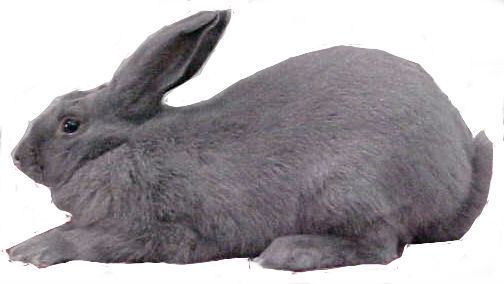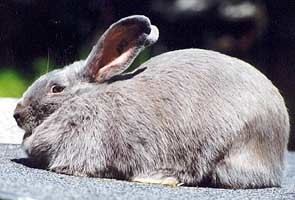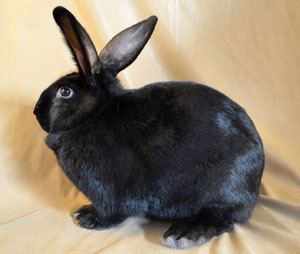Scientific name Oryctolagus cuniculus Rank Breed | Higher classification European rabbit | |
Similar Havana, Argente rabbit, English Lop, Florida White rabbit, English Spot | ||
The Beveren is one of the oldest and largest breeds of fur rabbits. It was first bred in Beveren, a small town near Antwerp in Belgium. Their coats can be blue, white, black, brown and lilac, though not all of these varieties are ARBA-recognized. There is a rare variety called the Pointed Beveren, which comes in the same colors but has white tipped hairs. The blue variety is the original.
Contents
- Schedule of points
- Show classes and weights
- Body
- Head
- Ears
- Feet and legs
- Fur
- Color
- Black
- Blue
- White
- Condition
- References
The Beveren rabbit is a rare breed. They are well tempered, clean, and smart. Beverens are full of energy, and love to explore the outdoors. They are recognized by the American Rabbit Breeders Association in three different colors, Black, Blue, and White. The coat should be dense and glossy with a gentle rollback fur type. Fur length is rather long having an average of 1¼ to 1½ inches. This large breed has a pronounced mandolin shape. Senior Bucks weight 8 to 11 pounds and Senior Does weight 9 to 12 pounds (American Rabbit Breeders Association (2016) Standard of Perfection. Bloomington, Il: Author). Their litters are large, the young grow fairly fast, and the does are typically docile and make good mothers.

Schedule of points

GENERAL TYPE: 55 points Body: 30 points Head: 10 points Ears: 5 points Feet & Legs: 5 points FUR: 20 points COLOR: 20 points CONDITION: 5 points TOTAL POINTS: 150 points
Show classes and weights


Juniors and intermediates which exceed maximum weight limits may be shown in higher age classifications. No animal may be shown in a lower age classification than its true age.
Body

30 Points. The body type is to be of mandolin shape. Body is to be medium length, with broad, meaty back and a deep, firm loin. Shoulders are to be strong and firm, with a well-sprung rib cage, tapering slightly from broader, smooth hips. The body should present a definite arch when viewed from the side. The topline is to be a smooth curve, starting at the back of the shoulder, rising to a high point over the middle of the back, and curving over the hips to complete the arch.
Head
10 Points. The head is to be full from top to bottom, with a well-filled face and jaws. Head is to present a distinct curvature between the eyes and nose with a medium broad muzzle. Size of the head is to conform to the body more massive in bucks than in does. A medium dewlap is permissible on does.
Ears
10 points. ears are to be well furred and carried in a "V" shaped manner. Ideal length is to be 5 or more inches in seniors and intermediates.
Feet and legs
5 points. Front feet and legs are to be straight, strong and of medium bone. Hind feet and legs are to be straight, powerful, and well furred. Legs are to be medium bone, in proportion to size of body. In whites, toenails are to be white or flesh colored. In blacks and blues, toenails should be dark.
Fur
20 points. The coat is to be very dense and glossy. The guard hairs should be plentiful and of fine diameter, but strong enough to fall or roll gently back into position when stroked from tail to head. Density and texture share equal importance. Ideal fur length is between 1¼ and 1½ inches. (Recommended for showing in breed fur.)
Color
20 Points.
Black
Color is to be deep, glossy, jet black, carried well down into a blue undercolor.
Blue
Color is to be a clean shade of light lavender blue, carried well down into the base, free from silvering.
White
Color is to be pure white, with no ivory cast.
Condition
5 Points.
